Photographs: Gary Rothstein/Pool/Reuter
After a 13-day long successful mission that enabled it to deliver the final US components of the International Space Station, space shuttle Discovery landed back on Earth after its final space flight.
Discovery: 25 years of spaceflight
Discovery will now end its days as a museum piece to delight the crowds.
TRIVIA: Shuttle Discovery's facts and feats
The shuttle cruised onto the runway at Kennedy Space Centre at 1657 GMT, wrapping up a rich, 27-year career in spaceflight that has spanned more distance and endured longer than any of the remaining three US shuttles.
"And Houston, Discovery. For the final time, wheelstop," Commander Steve Lindsey said when the orbiter came to a halt on the runway.
...
Discovery's final journey to Earth
Image: Discovery as seen through a window aboard the ISSPhotographs: Reuters
'This legend has spent 365 days in space'
Image: Discovery Pilot Eric Boe (L), Commander Steve Lindsey and mission specialist Alvin Drew (R) work on the aft flight deck of the shuttlePhotographs: Reuters
Discovery's arrival back on Earth marks the beginning of the end for the three-decade old US shuttle programme, which will formally close down after Endeavour and Atlantis take their final spaceflights in the coming months.
"This legend has spent 365 days in space," NASA mission control in Houston said, noting that over the course of its 39 missions, Discovery has logged almost 241 million kilometers.
Discovery's final journey to Earth
Image: Discovery's vertical stabiliser, orbital maneuvering system pods, remote manipulator system and payload bay are featured in this photo provided by NASAPhotographs: Reuters
Discovery's last trip to the International Space Station was initially scheduled to last 11 days but was extended to 13 so that astronauts could work on repairs and install a spare room.
The new permanent module they brought to the orbiting lab adds 21 by 15 feet of extra room for storage and experiments.
Astronauts also carried the first humanoid robot to the International Space Station (ISS), though it spent most of its time wrapped in packing materials and will not become fully operational for some time.
Discovery's final journey to Earth
Image: NASA astronaut Michael Barratt watches a water bubble float freely near him on the middeck of space shuttle DiscoveryIt was the first shuttle to return to flight after both the shuttle Challenger and Columbia accidents; launched the trailblazing Hubble Space Telescope; made the first US rendezvous with the Russian Mir space station; and made the first and last shuttle trips to rotate crews on the ISS.
'We couldn't be more pleased'
Image: An orbital sunrise brightens this view of space shuttle Discovery's vertical stabilizerPhotographs: Reuters
NASA will announce Discovery's final destination on April 12, the 30th anniversary of the first shuttle launch.
The anniversary falls during a time of uncertainty for the National Aeronautics and Space Administration's own future.
"We couldn't be more pleased," said LeRoy Cain, NASA's mission management team chairman. "The team just did an outstanding job. The entire space shuttle system just performed outstanding on this entire mission."
Discovery's final journey to Earth
Image: NASA astronaut Eric Boe, STS-133 pilot, uses a still camera at an overhead window on the aft flight deck of Discovery to photograph the ISSPhotographs: Reuters
NASA officials have largely focused on the ongoing mission rather than the history Discovery is about to make, but occasionally mention that they will be sad to see the shuttle end its long career.
"It's bittersweet and, quite frankly, sad knowing when we land that'll be the end for this vehicle," commander Steve Lindsey said last week in a press conference from space.
Discovery's final journey to Earth
Image: The ISS is seen in this view from the Discovery with the earth's horizon in the backgroundPhotographs: Reuters
"It will take the public a few years to realise the capabilities the shuttle actually had," he said, noting the space station could not have been built without the shuttle fleet's heavy lifting capability.
"There's nothing that's going to come even close to that being developed," he said.
Discovery's final journey to Earth
Image: NASA astronaut Catherine Coleman, Expedition 26 flight engineer, occupies the commander's station on the flight deck of DiscoveryPhotographs: Reuters
In the short term, the agency must rely on Russian Soyuz vehicles to carry astronauts aloft.
NASA has two more shuttle missions planned -- Endeavour's STS-134 flight in April, and the programme's swan song, Atlantis' STS-135 flight in June.

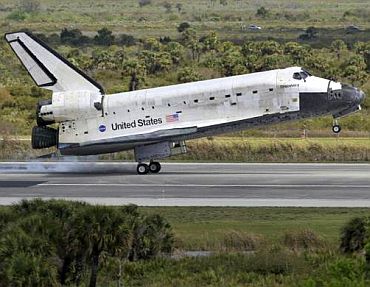


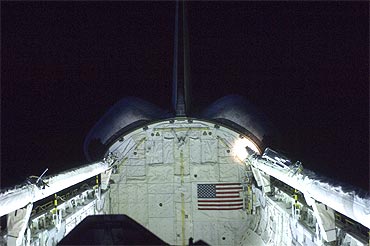
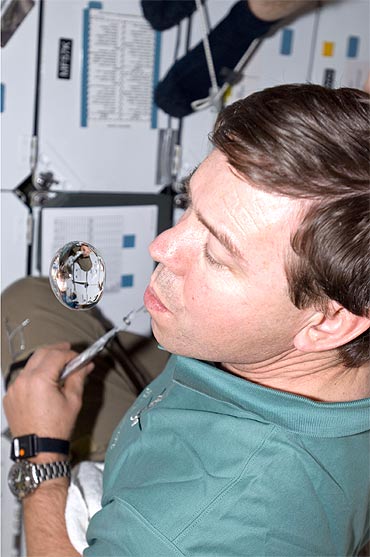
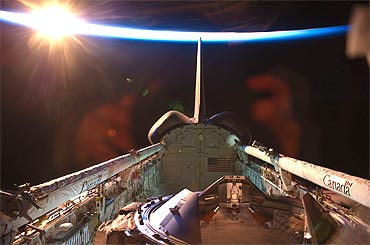
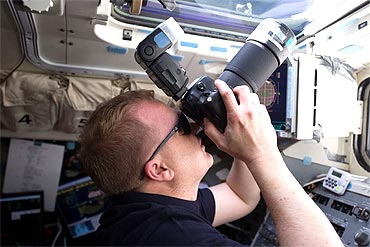
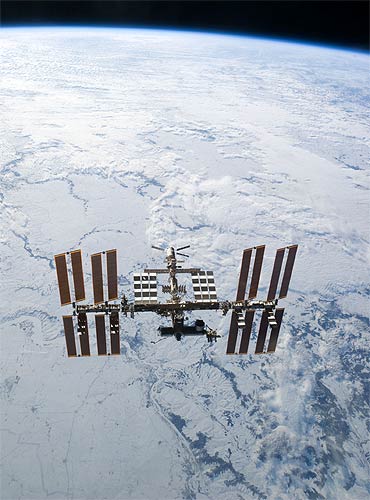

article